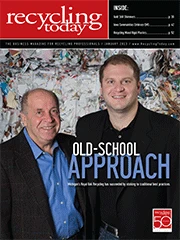 Electronics recycling has become one of the fastest growing segments of the recycling industry, attracting increased interest from strategic and financial investors. Positive dynamics that point to continued growth and consolidation in the e-cycling industry include:
Electronics recycling has become one of the fastest growing segments of the recycling industry, attracting increased interest from strategic and financial investors. Positive dynamics that point to continued growth and consolidation in the e-cycling industry include:
- Heightened regulatory pressures and legislative support for e-cycling;
- Significant increases in e-scrap volumes driven by the proliferation and shorter lifespan of electronics; and
- Development of an innovative and cost-effective recycling infrastructure.
In light of recent growth and the highly fragmented nature of the industry, electronics recycling companies have become attractive targets for investors. The industry is in the early stages of consolidation, and considerable opportunities exist for new participants to make platform investments or for existing companies to supplement their growth through acquisitions.
Industry Overview
The e-cycling industry consists of companies that provide a variety of services dedicated to the responsible recovery, recycling, refining and remarketing of unwanted electronics. Globally, e-scrap represents the fastest growing municipal waste stream. It is estimated that from 20 million to 50 million metric tons of e-scrap are generated worldwide annually, representing more than 5 percent of all municipal solid waste (up from 3 percent in 2009).
Significant attention has been directed toward the effective management of e-scrap in recent years because of rising concerns about environmental pollution, high and volatile commodity prices and resource scarcity.
According to ABI Research, Oyster Bay, N.Y., global revenue generated from e-cycling is expected to reach $14.7 billion by the end of 2014, up from $5.5 billion in 2009, representing a five-year compounded annual growth rate (CAGR) of 21.7 percent.
While the e-cycling industry spans multiple continents, it remains a highly fragmented sector with up to 1,000 active companies, according to industry estimates. Companies tend to be local or regional, leveraging an understanding of localized market dynamics and supplier relationships. Very few e-cycling companies have established a global reach; however, companies such as Sims Metal Management offer integrated services across multiple regions/countries.
The fragmented nature of the market, along with positive underlying dynamics, makes e-cycling an attractive sector for industry consolidators looking to capitalize on strong organic growth.
Growth Drivers
Positive macro trends are fueling strong secular growth as the industry continues to rebound from the economic downturn. Awareness of the potentially hazardous effects of electronic scrap and the need for efficient and cost-effective disposal solutions are increasing.
The following key drivers are expected to contribute to long-term growth in the e-cycling market.
Heightened regulation and legislation. The e-cycling industry is largely dependent on legislation to act as the primary driver of market momentum. A patchwork of e-scrap legislation and mandated product take-back programs across different regions throughout the world has placed markets at varying stages of development. Europe maintains the strictest legislation related to the disposal of sensitive materials, which can largely be attributed to the Waste Electrical and Electronic Equipment (WEEE) Directive and the Restriction of Hazardous Substances (RoHS) Directive. These directives provide for producer responsibility for electronics and impose restrictions on the use of certain hazardous substances in electronic equipment. While this legislation has been well-received, studies indicate continued demand for enhanced regulatory reform that will drive further e-cycling efforts throughout Europe.
Outside of Europe, regulations continue to develop and change quickly in many countries. In most cases, the scope of these regulations varies. For example, the U.S. currently does not have a federal mandate to recycle electronics. However, as of October 2012, 25 states had enacted electronics recycling laws, according to the U.S. Environmental Protection Agency (EPA). Meanwhile, countries such as Japan, South Korea and Taiwan have made fast inroads into this sector.
Regardless of the region, the general global consensus is that the recent increase in the implementation of new and existing legislation for e-scrap will continue. This sentiment is expected to lead to a heightened regulatory environment that will largely determine the pace of market development in this sector. For the time being, the current diversity of legislation across regions will favor larger industry players that have the necessary resources to manage the various regulatory complexities.
Increase in e-scrap volumes. E-scrap volumes are poised for continued growth in light of the proliferation of new electronic devices and the increasing rate of product obsolescence. A strong indicator of this dynamic is the rise in global sales of electronics. According to Stamford, Conn.-based Gartner Inc., a prominent technology research firm, global unit sales of computers, tablets and televisions are up approximately 15 percent, 430 percent and 3 percent, respectively, from 2010 to 2012, while global cell phone sales were up by nearly 40 percent in 2011 alone.
In addition to the increase in volumes, the amount of e-scrap actually recycled remains a limited percentage of the total e-scrap generated, providing additional opportunity for growth. The recycling rate for electronics in the U.S. was only 19 percent in 2010, according to the EPA, up from 13 percent in 2008.
Developing recycling infrastructure. The e-cycling sector is a dynamic market in which services and solutions are constantly evolving. Top e-cycling providers are actively investing in collection and processing techniques that provide additional value to customers.
E-cycling companies also are increasing attention on, and investment in, obtaining industry certifications. Customers have begun demanding these certifications (e.g., e-Stewards Standard, Responsible Recycling Practices [R2], IDC G.R.A.D.E. and ISO 14001, etc.) from their e-cycling providers. Most customers—especially financial institutions and government agencies—want assurances that sensitive information stored on hard drives is not exploited by e-cyclers. In addition, customers want to ensure their electronics are being handled in a socially and environmentally responsible way.
Finally, electronics manufacturers are establishing e-cycling programs that promote the continued development of e-cycling and improved infrastructure. For example, Samsung Electronics promotes take-back systems to comply with global recycling laws and is expanding its voluntary take-back programs to reduce its environmental impact through recycling.
M&A Trends
Recycling M&A volume was relatively robust in Europe and Asia from 2000 to 2008; however, industry consolidation slowed from 2008 to 2010 as a result of weakening demand for e-cycling services and general economic uncertainty. With the recent market recovery, acquisition activity in the sector has increased globally with significant interest coming from strategic acquirers. Transaction volume is expected to be higher still in 2013, driven by expected tax regulation changes, the strengthening balance sheets of recycling service providers and improving debt markets for financial investors.
Transaction multiples measured as a multiple of enterprise value to LTM EBITDA (the rate of change in earnings before interest, taxes and amortization in the last 12 months compared with the prior 12 months) have been somewhat volatile in recent quarters. It is anticipated that transaction multiples will be reinforced during the next several quarters by the need for strategic and financial acquirers to deploy capital. Premium multiples will be paid for attractive assets in high growth segments.
Historically, e-cycling transaction volume has represented a small portion of overall M&A activity in the recycling industry. While recent increases in e-cycling M&A have come from larger industry consolidators and new entrants diversifying existing service offerings, the universe of potential acquirers for e-cycling businesses spans multiple sectors with varying degrees of strategic fit. For example, a competency in electronic product collection is attractive to a firm seeking to expand or acquire capabilities in reverse logistics. However, in instances where the e-cycler is reselling parts or remanufactured products, they also must understand forward logistics capabilities, such as customer service, merchandising and retail elements relating to the target’s customer base.
Several categories of strategic acquirers likely will continue acquisition activity in the e-cycling sector, including diversified waste and recycling service providers, electronic manufacturing service providers, recycling service providers and companies that provide technology life-cycle management and logistics.
Arrow Electronics Inc., headquartered in Englewood, Colo., has been one of the more active buyers in the sector, with the acquisition of four U.S.-based e-cycling companies and one European company in the past three years. As a distributor and reverse logistics provider for IT products, Arrow can leverage these e-cycling assets to provide coordinated, end-to-end services to its clients.
This is one example of an acquisition strategy that is expected to stimulate interest from other companies in the sector hoping to stay competitive.
A lack of e-cycling targets with reasonable scale has limited acquisition activity by private equity firms; however, recent consolidation has created an opportunity for investment in the sector. Further, private equity investors could consider buying or building a diversified services firm with an e-cycling and/or reverse logistics service offering, gaining exposure to the sector while increasing the overall value added to the end customer.
Complementing such building interest in M&A activity from private equity investors, we expect venture capital attention on the e-cycling sector to continue in light of the potential for significant industry growth and the improving visibility for near-term, profitable exits.
E-cycling is a fast-growing sector that should continue to attract healthy interest from domestic and foreign acquirers. Strategic and financial investors have access to capital, and competition for attractive assets will support healthy valuations for willing sellers. It is expected that favorable long-term demand prospects, supported by government regulation, significant increases in e-scrap volumes and further investment in the recycling ecosystem, will continue to drive substantial M&A activity in 2013 and beyond.
The author is a senior member of Chicago-based Lincoln International’s Business Services Group. He leads or assists in leading deal teams and is active in marketing the firm’s services. He also leads Lincoln International’s analyst recruiting activities. He can be contacted at smehta@lincolninternational.com.

Explore the January 2013 Issue
Check out more from this issue and find your next story to read.
Latest from Recycling Today
- NRC seeks speakers for October event
- LME identifies Hong Kong warehouses
- Greenville, Mississippi, launches aluminum can recycling program
- Cotton Lives On kicks off 2025 recycling activities
- Georgia-Pacific names president of corrugated business
- Sev.en Global Investments completes acquisitions of Celsa Steel UK, Celsa Nordic
- Wisconsin Aluminum Foundry is a finalist for US manufacturing leadership award
- MetalX announces leadership appointments





